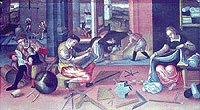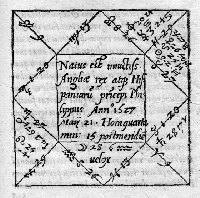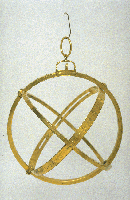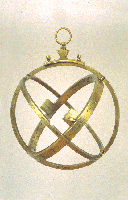
The Measurers:
a Flemish Image of Mathematics in the Sixteenth Century
 The Collectors
The Collectors
The activities of connoisseurs and patrons form a link between the historical period relevant to
the exhibition and the more recent collections which have shaped the resources available for display today.
The Habsburg rulers of the Netherlands in the sixteenth century were, to varying degrees, patrons and
collectors. Mercator, for example, made a large number of mathematical instruments for the Emperor
Charles V, who also commissioned Mercator's first globe in 1541. Charles was a patron of Gemma and he
brought the Spanish mathematician and astrolabe designer Juan de Rojas to the Netherlands, where he
studied under Gemma at Louvain. Charles was also a patron of Peter Apian and Apian's lavish book
Astronomicum Cęsareum, which might as easily be called an instrument in the form of a book,
was dedicated to Charles and his brother Emperor Ferdinand I.
 The heirs of both the 'Caesars' of Apian's title became patrons of the arts and sciences. Charles's son,
Philip II of Spain, was an avid collector: his activities are well known for laying the foundation of the
collections in the Prado Museum, but he was also fascinated by maps and mathematical instruments. He is
said to have owned 137 astrolabes and watches (Parker, p. 48). In Ferdinand's son Emperor Maximilian II,
extended patronage from his court in Vienna and his own son, Albert VII, Archduke of Austria, continued
this spirit in the Netherlands. He became Governor of the Spanish Netherlands in 1595 and joint
sovereign through his marriage to Philip II's daughter, Isabella Clara Eugenia, in 1599. Coignet's
manuscript account of his pantometric rules (see figures 7 and 8) is dedicated to Albert and an astronomical
rings in the exhibition (see figure 48) was made for Albert and Isabella.
The heirs of both the 'Caesars' of Apian's title became patrons of the arts and sciences. Charles's son,
Philip II of Spain, was an avid collector: his activities are well known for laying the foundation of the
collections in the Prado Museum, but he was also fascinated by maps and mathematical instruments. He is
said to have owned 137 astrolabes and watches (Parker, p. 48). In Ferdinand's son Emperor Maximilian II,
extended patronage from his court in Vienna and his own son, Albert VII, Archduke of Austria, continued
this spirit in the Netherlands. He became Governor of the Spanish Netherlands in 1595 and joint
sovereign through his marriage to Philip II's daughter, Isabella Clara Eugenia, in 1599. Coignet's
manuscript account of his pantometric rules (see figures 7 and 8) is dedicated to Albert and an astronomical
rings in the exhibition (see figure 48) was made for Albert and Isabella.
Collecting was not confined to the ruling class. Prosperous Flemish burghers joined the vogue and the
paintings they commissioned to record their collections, in the popular genre of cabinets
d'amateurs, depict globes and mathematical instruments along with paintings, natural history
specimens, musical instruments and all manner of curiosities and exotica. One such painting, by Jan
Brueghel the Elder and Frans Francken II, includes Albert and Isabella as though visiting a collection but
perhaps included as a symbol of the nobility of patronage (see Michel, p. 89).
If we turn to those whose taste and judgment have had a more immediate effect on our exhibition and
whose collections are cited in the catalogue entries, Lewis Evans was the most influential. Not without
reason was the Museum of the History of Science originally called the Lewis Evans Collection. His
particular interest was in mathematical instruments, especially astrolabes and sundials, and as a careful,
knowledgeable and discerning buyer from dealers and sale rooms, he built up an outstanding collection.
Through its presentation to the University of Oxford in 1924, his collection came to have a considerable
influence on the history of science and the study of mathematical instruments. Many of the books on
display are also from his collection.
 A second notable benefaction to the Museum, represented in the provenances of the instruments on
display, was that of the merchant shipper Jack Billmeir, who presented his collection in 1957. He had
formerly acquired many of the instruments of Henri Michel, the Belgian collector and historian of
scientific instruments, so that a good part of Michel's collection is preserved in Oxford. Michel was
inclined to add to his instruments (see catalogue numbers 32 and 44) and to commission or to make pieces which
he felt represented gaps in his collection.
A second notable benefaction to the Museum, represented in the provenances of the instruments on
display, was that of the merchant shipper Jack Billmeir, who presented his collection in 1957. He had
formerly acquired many of the instruments of Henri Michel, the Belgian collector and historian of
scientific instruments, so that a good part of Michel's collection is preserved in Oxford. Michel was
inclined to add to his instruments (see catalogue numbers 32 and 44) and to commission or to make pieces which
he felt represented gaps in his collection.
If Michel stands for the collector-scholar, a final collector type represented in the exhibition is the
collector-dealer. Gertrude Hamilton wrote a pioneering, but unpublished, book on Old Scientific
Instruments and published a catalogue of what she called 'The Mercator Collection', but she came to
scientific instruments through her work as a dealer. Her shop in Paris, which at first stocked early maps
and atlases, extended its range into scientific instruments and was named after the great Flemish
cartographer and instrument maker.
See catalogue numbers 41 to 47
Bibliography
Contents
(c) Museum of the History of Science, Broad Street, Oxford, England.
 The heirs of both the 'Caesars' of Apian's title became patrons of the arts and sciences. Charles's son,
Philip II of Spain, was an avid collector: his activities are well known for laying the foundation of the
collections in the Prado Museum, but he was also fascinated by maps and mathematical instruments. He is
said to have owned 137 astrolabes and watches (Parker, p. 48). In Ferdinand's son Emperor Maximilian II,
extended patronage from his court in Vienna and his own son, Albert VII, Archduke of Austria, continued
this spirit in the Netherlands. He became Governor of the Spanish Netherlands in 1595 and joint
sovereign through his marriage to Philip II's daughter, Isabella Clara Eugenia, in 1599. Coignet's
manuscript account of his pantometric rules (see figures 7 and 8) is dedicated to Albert and an astronomical
rings in the exhibition (see figure 48) was made for Albert and Isabella.
The heirs of both the 'Caesars' of Apian's title became patrons of the arts and sciences. Charles's son,
Philip II of Spain, was an avid collector: his activities are well known for laying the foundation of the
collections in the Prado Museum, but he was also fascinated by maps and mathematical instruments. He is
said to have owned 137 astrolabes and watches (Parker, p. 48). In Ferdinand's son Emperor Maximilian II,
extended patronage from his court in Vienna and his own son, Albert VII, Archduke of Austria, continued
this spirit in the Netherlands. He became Governor of the Spanish Netherlands in 1595 and joint
sovereign through his marriage to Philip II's daughter, Isabella Clara Eugenia, in 1599. Coignet's
manuscript account of his pantometric rules (see figures 7 and 8) is dedicated to Albert and an astronomical
rings in the exhibition (see figure 48) was made for Albert and Isabella.
 The Collectors
The Collectors